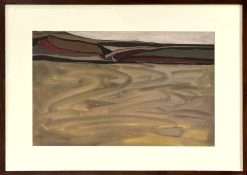
Sirak Melkonian (born in 1309 - died in August 1403)
He was an Armenian-Iranian painter and one of the pioneers of modern Iranian art. In his works, he shows abstract landscapes in an abstract way, with emphasis on line and form. The works of this artist depict a nature that is neither imaginary nor real, neither meta-realistic nor realistic, in a unique language.
As a teenager, after finishing high school, he met Marko Grigorian and learned about modern European and world art through him. Melkonian's early works had a figurative and realistic approach. In 1336, he won the Iranian Contemporary Artists Award in the Iran-American Association and in 1337, he won the Tehran Biennale Grand Prize. After that, encouraged by Gregorian, he went to Italy to study art and studied at the academy, but left it halfway and continued to learn art experimentally. He participated in the Venice Biennale and shortly after won the first prize of the Paris Biennale.
Limited color palettes and emphasis on line and form in Sirak Melkonian's works have always been more important than the subject. Over time, the figurative language of his works has become expressionistic and then abstract. Melkonian's mastery over the visual qualities of line and color has created perfect coherence and balance, and perhaps this feature can be considered the closest common feature of his works to pristine nature.
Over the years, Melkonian has participated in many solo and group shows in Iran and other countries. In the years before the revolution in the 1950s, he won first place in the Tehran International Art Exhibition. His works were displayed in the third exhibition of Tehran Azad Group in 1354, Art Fair Wash Art 77 and Art Fair Fiac 77.



 فارسی
فارسی